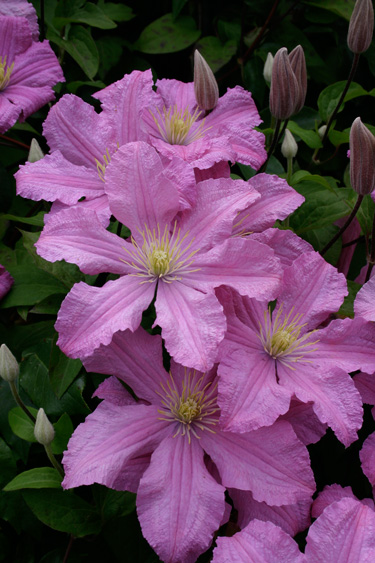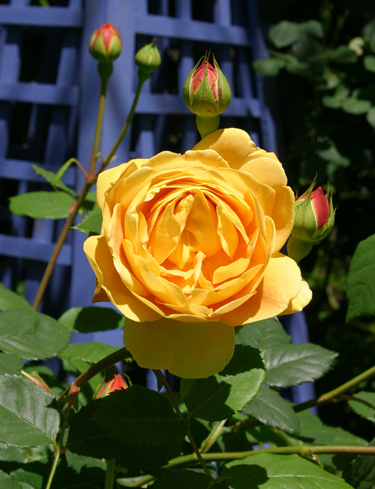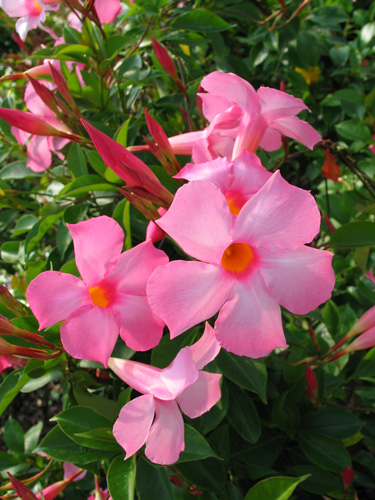Summer's hottest climbers
Any empty fence, wall or pergola is the gardener’s equivalent of a blank canvas. Even when the available vertical space is taken, there’s always a way to make more; many an obelisk, archway or trellis has been built in honour of a seductive climbing plant.
In summer, climbers are more captivating than ever. Grown over pergolas they offer cool relief from scorching sun. When privacy is called for in outdoor living areas, climbers are an ideal solution, especially if space is tight. Demanding minimal space compared to trees and hedges, they quickly convert a fence or trellis into a green leafy screen.
When choosing climbers for your garden, consider your soil type and climate, also the available microclimates you may have in your garden. For example, a frost tender climber can thrive in a cooler climate when grown against a north-facing wall that traps the sun’s warmth. Also consider whether or not you want year round foliage. A deciduous climber can work brilliantly when if you want summer shade and winter sun.
Fragrance
Intensely fragrant star jasmine (Trachelospermum jasminoides) is one of the most versatile and popular landscape plants and will cope with light frost. It will sprawl as a weed-stopping groundcover or can be trained on wires as a climber. The dense evergreen foliage is covered in little white flowers from late spring through summer.
From the tropics and for frost-free gardens only we have richly scented Madagascar Jasmine (Stephanotis floribunda), a glossy evergreen with pure white waxy trumpets, and Herald's trumpet (Beaumontia grandiflora), a larger vine with deeply veined, evergreen foliage and large white trumpet flowers. Petrea volubilis is a picture in November when it is covered with long bunches of purple star flowers.
Chilean Jasmine (Mandevilla laxa) is asuper scented option for cooler climates. This tough deciduous vine makes up for its gawky winter appearance in summer when it fills the air with its delicious gardenia perfume. The clusters of white 5cm trumpets are lovely against the deep green foliage. It’s not too rampant, so plant it where its scent can be fully enjoyed!
Extreme colour
Hot pinks, fiery reds and oranges and vibrant purples, Bougainvilleas are arguably the showiest of all summer bloomers. They’re at their colourful best in a hot dry location. Rampant vines with lush foliage at the expense of flowers are likely to be growing in soil that is too rich and moist. Bougainvilleas are really more of a vigorous sprawling shrub than an actual vine but they are easily trained against walls or as shrubs in pots. There are some dwarf shrub forms, even more ideal for pots. Trimming during spring and summer promotes new growth and flowering. Long leafy ‘water shoots’ that grow from the base should be removed completely.
Beautiful Mandevillas (aka diplaednia) have the flower power of a bougainvillea without the rampant growth habit. Dark green, glossy evergreen foliage creates the perfect foil for their flamboyant trumpet flowers, which keep on coming until late autumn. In the far north they may flower all year round.
They hail from the high altitude rain forests of Central and South America where the rain flows freely but drains quickly through the soil. So, while water is a great friend of the mandevilla, free draining soil is essential. The best location is a frost-free spot with protection from the hottest afternoon sun. The good news is that, if your soil is heavy or your winter frosty, you can grow mandevillas in containers. Their slender twining stems require support if you want them to climb, but at only 2 to 3m high, they can be accommodated in the smallest of gardens. They can also be grown as a ground cover or, if well fed and watered, in a large hanging basket. To encourage bushy growth and prolific flowering, feed fortnightly with high potassium fertiliser and pinch out the growing tips. Varieties come in rich shades of pink and red, as well as white.
Ideal for a slightly larger space in a frost-free garden, the charming Brazilian twiner, Mandevilla splendens ‘Alice du Pont’ never fails to impress with her striking pink trumpet flowers and attractive foliage. The big leathery leaves take on a puckered look with deep sunken veins. ‘Splendens’ means splendid.
Exotic
Summer’s hybrid clematis cultivars have huge exotic flowers compared with its spring flowering cousins, but the plants themselves are nowhere near as rampant. These climbers are well suited to a small trellis or large container. They can be grown among shrubs and old-fashioned roses. Flowers appear from late spring till mid-summer on the stems of the previous year's growth. Meanwhile, new growth is being formed which produces more flowers during late summer and autumn.
Take extra care not to disturb the roots or break stems when planting clematis as this invites the killer wilt disease. Plant them where their roots will be cool and moist and add a layer of organic mulch, but take care to keep the mulch away from the stem. Clematis are heavy feeders. Add sheep pellets or well rotted animal manure at planting time top up with slow release fertiliser every spring. If growing Clematis in a pot make sure it is a large one, at least 20 litres. Provided they are kept well watered, terracotta pots offer better protection against summer heat and winter cold than plastic pots. Apply slow release fertiliser or feed fortnightly with balanced liquid fertiliser.
Edible
It’s passion fruit planting time. Plant a young vine in a warm sunny location this November and you could be eating its delicious aromatic fruit within 18 months. Encourage side branching by pinching out the growing tip and train the new laterals along a trellis or wire support. Pruning off some of the old wood each year encourages vigorous new fruiting growth. However, a passion fruit vine only will fruit well for five or six years, so if you have one reaching retirement age it may be time to plant a new one. Grapevines not only provide delicious fruit, their foliage is beautiful too, ideal for summer shade.
Romantic
Climbing roses are among the most seductive climbers or all. The most romantic of them are the vigorous old ramblers that flower only once (but profusely) in early summer. When there is space for only one climbing rose, there are hundreds of smaller growing, repeat flowering varieties to choose from. Popular favourites include deep red ‘Dublin Bay’, and golden yellow ‘Graham Thomas’.
Success with climbers
- Most climbers grow best with their roots in cool soil and their flowers in the sun.
- At planting time, mix in compost, plus blood and bone or slow release fertiliser.
- Mulch to keep moisture in and weeds out. Fine bark is ideal.
- Water newly planted climbers regularly over summer.
- Be sure to provide appropriate support. Vigorous woody climbers need a solid structure with posts set in concrete.

30-Oct-2015

Hybrid clematis

English rose Graham Thomas

Colourwave Mandevilla "Pink Mini"

